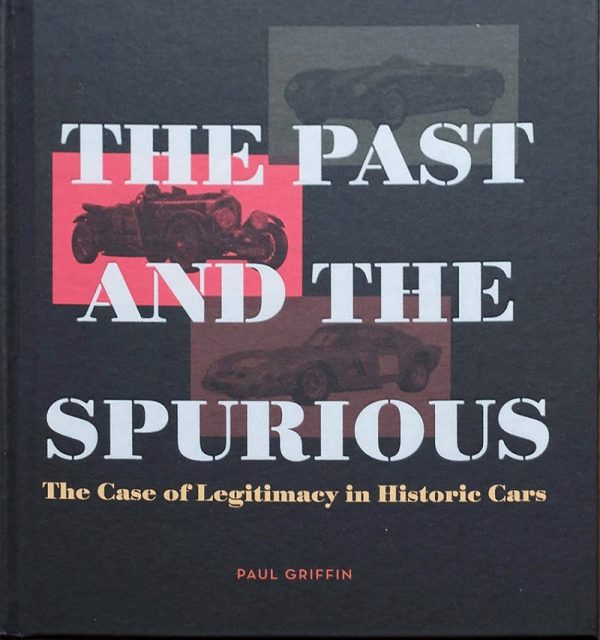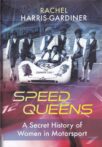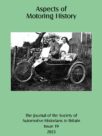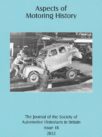
by Paul Griffin
2022 review by James Loveridge
(N.B. This book was entrusted to our Chairman, but, as he found more than one case within its covers with which he had been intimately involved, he “declared interest” and passed over review duties!)
SAHB Member and distinguished lawyer Paul Griffin’s new book could almost be described as a text book dealing, as it does, with the perennial conundrum for historians, what is the Truth. Certainly the appearance of Plutarch, Aristotle and Hobbs in a book about motoring (a first since Setright?) is well justified.
It could equally be described as a mini encyclopaedia as it covers not only issues of originality, history, provenance etc but also what is available to substantiate claims of genuineness. There are helpful detailed descriptions of the various laws and regulations in place to identify motor vehicles, from the FIA, other umbrella motor sport authorities, race organisers and motor clubs. Even the DVLA gets into the act but – spoiler alert – there currently aren’t any rules which conclusively resolve the problem.
In Chapter 2, Identity and Change, we are given a very interesting account of how some very well known sports and racing cars have been identified during their “lives”. However, probably most readers will be inclined quickly to turn to the 76 pages which spell out the many cases which have gone to the English Courts. These cases show, the Bentley Old Number One case and Mr Tuke’s problems with JD Classics and Mr Hood are examples, some of the ways in which the truth has been interpreted if not outright molested. Particularly helpful is the skill with which Mr Griffin has explained the numerous Judges’ decisions in layman’s terms.
As we all know, most of the problems have arisen when it comes to the value of the car in money terms, not, though just as significant, so much in historical terms. In the good/bad old days, if the owner said it was a genuine old vehicle and if it looked right you tended to accept it. Only the “special” cars had histories. It was recognised that the older the car the more likely it was to have some replacement parts or alterations and that didn’t much matter. That is no longer good enough.
In satisfying detail the author explains the various tests which have been used to establish the true history of a vehicle: its provenance. Documented records are helpful both from factory records and books but, as several manufacturer didn’t keep records of individual cars or routinely swapped parts almost indiscriminately these are not conclusive. Other test such as the VIN number, long-term ownership, originality, the amount of restoration such as use of exact, modern, copies of original components, and, of course, human memory have been relied upon in many cases. On page 366 Mr Griffin gives a fourteen-point list of the sort of things to be considered in deciding if the car is “kosher”. Modern replicas of historic cars rather complicate things.
Mr Griffin quotes numerous sources which have concerned themselves with this thorny problem, thus demonstrating the depth and range of his research in preparing this most valuable book. Included among the many UK experts who have expressed opinions are Hugh Young, Doug Nye, Anders Clausager and the much missed Denis Jenkinson, but it is clear that quite a lot of thought on this vexed subject comes from elsewhere in the world, with Fred A Simeone and Dietrich Hatlapa among those quoted. There is also a very useful summary of vehicle registration in the UK and, in other parts of the book, how the DVLA has taken on the role of not just collecting revenue and listing vehicles legally on the road but also acting as judge and jury in some instances of doubt, e.g. two cars claiming the same registration number.
This self-published book is beautifully produced on gloss paper and profusely illustrated – and, thankfully, the illustrations are adjacent to the text to which the image refers. There is a mix of contemporary photographs and of artist’s works, some of which have been commissioned to complement the work.
A brief review cannot do full justice to this book and it is unreservedly recommended to all motoring historians. You may not have been planning to buy the £44 million Ferrari GTO but you will learn a lot of useful things about how to establish the true history of cars.
Publisher: The Griffin Press, 42 Lytton Road, Barnet, London, EN5 5BY
Price: £75.00. There is also a 100-copy limited leatherbound edition, which can include a 25-word tailored dedication, at £250.00. Both are available from the publisher, both exclusive of P&P.
Description: Hardback published without dustjacket, 267 x 216 mm, 418 pages, photographs in B/W and colour.
ISBN: 978-1-7397673-0-3







Leave a Comment